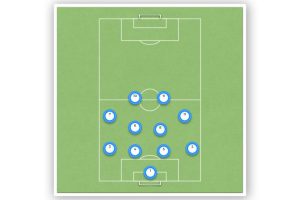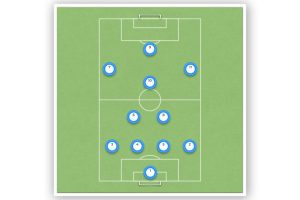Mastering the 4-3-3 Defensive Structure: Tips and Strategies
The 4-3-3 formation is a popular and effective soccer formation that has been used by many teams at different levels of the game. This formation is well-balanced and offers a good balance between defense and attack. The formation is made up of four defenders, three midfielders, and three forwards, creating a structure that allows for good defensive coverage while still creating attacking opportunities.
The 4-3-3 formation is known for its defensive structure, which allows for strength through the middle. With three central midfielders, the team can protect the defense, control the center of the pitch, and force the opposition to play out wide. This formation also allows for control of possession, which works best with technically competent players who pass, move, and recycle the ball around the team.
Many coaches have explained the 4-3-3 formation in detail throughout the years, with variations that suit different teams and playing styles. This article will explore the defensive structure of the 4-3-3 formation and how it can be used to create a strong defense while still allowing for attacking opportunities.
What is the 4-3-3 Defensive Structure?
The 4-3-3 defensive structure is a popular formation in soccer that emphasizes defensive stability and structure. It is often used by teams that prioritize a strong defensive foundation, while still maintaining an attacking threat. The formation consists of four defenders, three midfielders, and three forwards.
One of the strengths of the 4-3-3 defensive structure is that it allows for a solid defensive foundation. The back four provide excellent protection for the goalkeeper, and the midfield three are able to drop back and help defend when necessary. This makes it difficult for opposing teams to break through the defense and create scoring opportunities.
Another advantage of the 4-3-3 defensive structure is that it allows for quick counterattacks. With three forwards, the team is able to quickly transition from defense to offense and catch the opposing team off guard. This can lead to scoring opportunities and put pressure on the opposing defense.
However, the 4-3-3 defensive structure does have some weaknesses. One potential weakness is that it can be vulnerable to attacks down the flanks. With only two wide players in the midfield, it can be difficult to defend against opposing teams that use their wide players to attack.
Overall, the 4-3-3 defensive structure is a solid formation that can provide a strong defensive foundation while still maintaining an attacking threat. It is a popular choice for teams that prioritize defensive stability and structure.
Advantages of the 4-3-3 Defensive Structure
The 4-3-3 defensive structure is a popular formation in football that provides several advantages to teams that use it. This section will discuss some of the key benefits of the 4-3-3 formation and how it can help teams on the defensive side of the game.
Flexibility
One of the main advantages of the 4-3-3 defensive structure is its flexibility. The formation can be adapted to suit different game situations and opponent styles. For example, teams can use the 4-3-3 to play a high-pressing game, where they apply pressure on the opposition’s defense high up the pitch. Alternatively, they can use it to play a more reserved block, where they sit back and wait for the opposition to come to them.
Another advantage of the 4-3-3’s flexibility is that it allows teams to switch between offensive and defensive modes quickly. The formation’s three-man forward line can quickly transition from attack to defense, providing cover and protection in central areas.
Pressing
The 4-3-3 formation is also well-suited to pressing. A three-man forward line provides good numbers to apply pressure on the opposition defense, while the midfield three provides cover and protection in central areas. This is useful both when pressing high or converting into a more reserved block.
Teams that use the 4-3-3 formation to press high up the pitch can force turnovers and create scoring opportunities. The formation’s flexibility also allows teams to adjust their pressing intensity and style based on the situation.
Defensive Coverage
The 4-3-3 formation provides excellent defensive coverage, particularly through the middle of the pitch. With three central midfielders, teams can protect their defense, control the center of the pitch, and force the opposition to play out wide. This makes it difficult for the opposition to create scoring opportunities through the middle.
The formation’s back four also provides excellent protection for the goalkeeper, while the holding midfielder screens in front of them. This prevents opponents from exploiting any space in behind.
In summary, the 4-3-3 defensive structure provides several advantages to teams that use it. Its flexibility, pressing ability, and defensive coverage make it a popular choice for teams looking to control the game and limit their opponents’ scoring opportunities.
Disadvantages of the 4-3-3 Defensive Structure
The 4-3-3 defensive structure is a popular formation in soccer that provides a strong attacking presence on the field. However, it also has some drawbacks that need to be considered before using this formation.
Vulnerability to Counterattacks
One of the main disadvantages of the 4-3-3 defensive structure is its vulnerability to counterattacks. This is particularly true if the team is playing a high defensive line. The 4-3-3 shape can sometimes leave teams lacking slightly in defensive areas, particularly if their full-backs push up high. This can be especially dangerous in the event of opposition counter-attacks, which can be swift and direct.
Teams playing with a 4-3-3 formation need to be aware of the potential for counter-attacks and have a solid defensive strategy in place to prevent them. If the central defenders are not quick enough to recover, the team can be exposed to quick counter-attacks, leaving the goalkeeper vulnerable to one-on-one situations.
Overreliance on Midfielders
Another disadvantage of the 4-3-3 defensive structure is its overreliance on midfielders. In this formation, the midfielders are responsible for both attacking and defending. This can lead to fatigue and burnout, especially if the midfielders are not rotated frequently.
Moreover, the space left in the wide areas between the full-back and winger in a 4-3-3 can be exposed and targeted by the opposition. This is usually via quick counter-attacks and swift, direct switches of play. The midfielders may have to cover the wide areas, leaving the central areas exposed. This can lead to the opposition exploiting the space in the center of the field, leading to goals.
Overall, the 4-3-3 defensive structure is a formation that comes with certain drawbacks. Teams need to be aware of these disadvantages and have a solid defensive strategy in place to prevent counter-attacks and overreliance on midfielders.
How to Implement the 4-3-3 Defensive Structure
Positioning
Implementing the 4-3-3 defensive structure requires a solid understanding of player positioning. The back four provide excellent protection for the goalkeeper, while the midfielders are responsible for controlling the center of the pitch and forcing the opposition to play out wide. The three forwards should be positioned to press high up the field and apply pressure on the opposition defense.
Roles and Responsibilities
Each player in the 4-3-3 formation has a specific role and responsibility in the defensive structure. The two center backs are responsible for marking the opposition’s central forward, while the fullbacks provide cover for the center backs and prevent the opposition wingers from getting behind the defense. The defensive midfielder is responsible for shielding the back four and breaking up opposition attacks. The two central midfielders are responsible for controlling the center of the pitch and recycling possession. The two wingers are responsible for pressing high up the field and preventing the opposition from playing out from the back. The central forward is responsible for leading the press and preventing the opposition from playing through the center of the pitch.
Training and Practice
Implementing the 4-3-3 defensive structure requires practice and repetition on the training pitch. Coaches should focus on training players to stay in their positions and maintain their defensive shape. Coaches should also encourage players to communicate with each other and work together as a cohesive unit. Drills such as small-sided games and possession exercises can help players develop their defensive skills and understanding of the 4-3-3 defensive structure. Overall, implementing the 4-3-3 defensive structure requires a solid understanding of player positioning, roles and responsibilities, and training and practice. With the right preparation and coaching, teams can successfully implement the 4-3-3 defensive structure and achieve defensive success on the pitch.
Conclusion
The 4-3-3 defensive structure is a popular formation in soccer due to its balanced approach to defense and offense. With four defenders, three midfielders, and three forwards, the formation provides excellent protection for the goalkeeper, while the holding midfielder screens in front of them. This prevents opponents from exploiting any space in behind.
While the formation is known for its defensive structure, it also allows for a potent attack. The three forwards can create a lot of pressure on the opposition’s defense, while the midfielders can provide support and create opportunities for the forwards.
However, like any formation, the 4-3-3 has its weaknesses. One of the main weaknesses is that it can be vulnerable to counterattacks. With only four defenders, the team can be caught out of position if the opposition manages to break through the midfield. Additionally, the formation requires a lot of discipline and teamwork, as each player must fulfill their role and responsibilities to ensure the team’s success.
Overall, the 4-3-3 defensive structure is a versatile and effective formation that can be used by teams of all levels. It provides a balance between defense and offense, and if executed correctly, can lead to success on the pitch.





